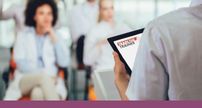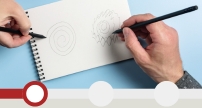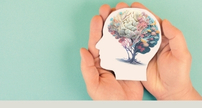Tremor & Essential Tremor
Clinical Overviews
Essential Tremor
Essential tremor (ET) is the most common tremor syndrome seen in adults. Essential tremor is an isolated tremor syndrome of bilateral upper limb action tremor with at least 3 years’ duration, as recently defined by the MDS Task Force for Tremor. Tremor in other locations (e.g., head, voice, or lower limbs) may (or may not) be present. But there are no other neurological signs, such as dystonia, ataxia, or parkinsonism. To further clarify and to delineate ET from other tremors, exclusion criteria were also formulated: Thus, isolated focal tremors (voice, head), orthostatic tremor with a frequency >12 Hz, task- and position-specific tremors and sudden onset and step-wise deterioration do not fall into the category of ET.
View complete description
The characteristic tremor seen in ET is postural and action tremors, with a frequency of 4-7 Hz. These tremors may begin insidiously early in life, with an increment in tremor severity over the years. The disability in ET is associated with impairment of voluntary activities that occur as a result of the tremor. Patients commonly complain of tremors when eating, drinking and writing, spilling over food and drinks and developing a progressively illegible handwriting. The most commonly affected body parts include hands, head and voice, but may also be seen in the legs, trunk and face.
Despite being mainly a postural tremor, kinetic tremor may be present and sometimes a resting tremor of lesser severity may be appreciated. The tremor in ET is exacerbated by conditions as stress, exercise and fatigue, caffeine, certain medications and improves with relaxation and small doses of alcohol. Patients frequently have a family history.
The most common treatments for ET include: beta blockers such as proporanolol, primidone and topiramate. Sometimes, in medication-refractory tremor, deep brain stimulation of the VIM nucleus of the thalamus is considered.
Contributed by Hubert Fernandez, MD
Head, Movement Disorders
Department of Neurology
Cleveland Clinic
Cleveland, Ohio USA
Updated 2019: Contributed by Susan A. Schneider, MD
Consultant Neurologist
University Hospital Munchen
Pullach, Germany
Tremor
Tremor is an involuntary, rhythmic, oscillatory movement of a body part. Tremor results from contractions of agonist and antagonist muscles entrained by a signal pattern originating from an oscillator in the central nervous system. Resting tremor occurs in a body part that is not activated and completely supported against gravity. Action tremor refers to tremor occurring with voluntary muscle contraction and is subdivided into postural tremor, isometric tremor and kinetic tremor. The latter is further subdivided into simple kinetic, intention tremor, and task specific tremor, such as writing tremor.
View complete description
The etiology of tremor is diverse, and includes essential tremor (with 50% having a positive FH but no single gene identified); as part of genetic disorders eg Wilson’s disease; degenerative such as Parkinson’s disease, Metabolic diseases (such as thyroid-, parathyroid-, liver disease and hypoglycemia); peripheral neuropathies (eg associated with Charcot-Marie-Tooth; drug-induced (including narcoleptics, tricyclics, lithium, cocaine, alcohol, adrenaline, bronchodilators, theophylline, caffeine, steroids, valproate, amiodarone, thyroid hormones, vincristine); toxins (heavy metals) and psychogenic/functional disorders.
The original consensus criteria proposed by MDS from 1998 were recently revised to better overcome inconsistencies, particularly with regard to essential tremor (ET), tremor associated with dystonia or other additional neurological abnormalities, and focal tremors. The new consensus proposes classification has two main axes: clinical features (Axis 1) and etiology (Axis 2).
Clinically, a syndrome consisting only of tremor is called an isolated tremor syndrome. On the other hand, a syndrome of consisting of tremor and other systemic or neurological signs is called a combined tremor syndrome.
Etiologically, tremor can be classified into physiological tremor, enhanced physiological tremor, essential tremor syndromes (including classical ET), dystonic tremor, parkinsonian tremor, cerebellar tremor (often associated with multiple sclerosis), Holmes’ tremor (a.k.a. rubral tremor), palatal tremor, neuropathic tremor, toxic or drug-induced tremor, and psychogenic tremor.
Contributed by Leo Verhagen, MD, PhD
Associate Professor of Neurological Sciences
Rush University Medical Center
Chicago, IL, USA
2019 Updates Contributed by:
Susanne A. Schneider, MD
Consultant Neurologist
LMU University Hospital Muenchen
Munich, Germany
Susan Fox, MRCP (UK), PhD
Professor of Neurology
University of Toronto, Toronto Western Hospital
Toronto, ON, Canada
Key Recommendations
Treatment
MDS Evidence-Based Medicine Review: Treatments for Essential Tremor (2019)
Diagnosis
Consensus Statement on the classification of tremors: From the MDS task force on tremor (2017)

Clinical Outcome Assessments
View clinical outcome assessments, including the Quality of Life in Essential Tremor Questionnaire (QUEST).

Information
Instructional Videos: How Do I?

From the Movement Disorders Clinical Practice journal.
Latest Articles and Media
Discover the latest coverage, analysis, and expert commentary about tremor.
![]()
Deep learning-based artificial intelligence algorithm to classify tremors from hand-drawn spirals
- Web article
- Tremor/Essential Tremor (ET)
![]()
New research delves into the phenomenology of tremor
- Web article
- Tremor/Essential Tremor (ET)
![]()
Tremor Series: What's in store? The future of tremor research
- Podcast
- Tremor/Essential Tremor (ET)
![]()
Tremor Series: The novel pharmacological and surgical treatments for tremor
- Podcast
- Treatment
- Tremor/Essential Tremor (ET)
![]()
Tremor Series: What’s essential tremor?
- Podcast
- Tremor/Essential Tremor (ET)
![]()
Tremor Series: So common, so difficult: The phenomenology of tremor
- Podcast
- Tremor/Essential Tremor (ET)
![]()
Clinical Neurophysiology for Tremor: Common Questions in Clinical Practice
- Published paper
- Neuroimaging
- Tremor/Essential Tremor (ET)
![]()
Tremor Series: How do we shake? The pathophysiology of tremor
- Podcast
- Neuroimaging
- Tremor/Essential Tremor (ET)
![]()
Transcutaneous spinal cord stimulation for essential tremor
- Podcast
- Tremor/Essential Tremor (ET)
![]()
Tremor Series: Why tremor?
- Podcast
- Tremor/Essential Tremor (ET)
![]()
The evolution of tremor • 2024 MDS Congress
- Podcast
- Tremor/Essential Tremor (ET)
![]()
Essential tremor and dystonia: the TITAN study
- Podcast
- Tremor/Essential Tremor (ET)
![]()
Unravelling the progression of tremor in Parkinson's disease
- Podcast
- Parkinson's Disease (PD)
- Tremor/Essential Tremor (ET)
![]()
Examining task-specific tremor in musicians
- Web article
- Tremor/Essential Tremor (ET)
![]()
Unraveling the mechanisms of tremorogenesis
- Web article
- Tremor/Essential Tremor (ET)
![]()
Advances in Treatments of Essential Tremor
- Web article
- Tremor/Essential Tremor (ET)
![]()
Remote measurement and home monitoring of tremor
- Published paper
- Telemedicine
- Tremor/Essential Tremor (ET)
![]()
Genetics of Essential Tremor
- Web article
- Genetics
- Tremor/Essential Tremor (ET)
![]()
Bilateral focused ultrasound thalamotomy for essential tremor, is it safe?
- Podcast
- Focused Ultrasound
- Tremor/Essential Tremor (ET)
![]()
Technological Advances for Tremor Assessment
- Web article
- Tremor/Essential Tremor (ET)

Video Case Library
Browse an archive of nearly 2,000 case videos and other multimedia, including various presentations of tremor and essential tremor. ✪ MEMBERS ONLY

Tremor Curriculum Tracks
Curated sets of courses and materials that guide you progressively through Tremor topics.

Fundamentals: Approach to Tremors
Learn about tremor classification, basic pathophysiological background, and differential diagnosis of tremor types, along with current treatment strategies.


















